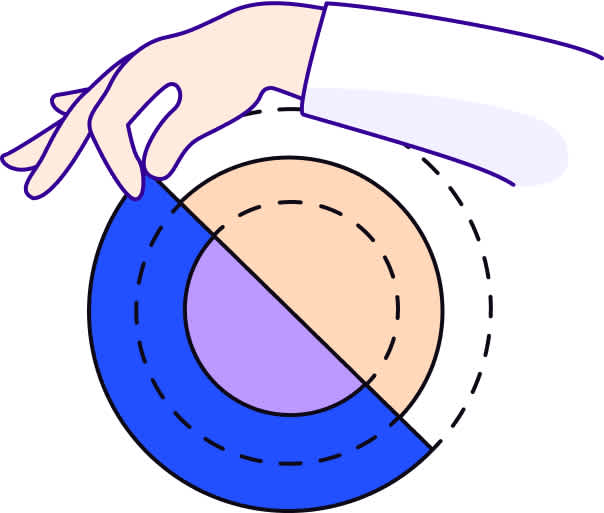You can rely on your intuition for a lot of things,
whether it’s to have an extra scoop of espresso gelato or to bring an umbrella with you even though it looks like sunny skies.
But you can’t rely on your intuition when it comes to predicting what your customers will or won’t respond to when they click, swipe, or scroll through your digital product. Sometimes they don’t even know why they respond the way they do. It’s unpredictable human nature.
You can guesstimate they’ll click on the blue button with the “Buy Now!” copy instead of a green button with the copy “Purchase Here,” but the best way to know what works is actually driven by data. We’re talking about A/B testing.
When you start testing elements at various touchpoints in your digital product, you discover what tracks with your users and what doesn’t. There’s no studying or homework involved, and your “grade” only helps you build and optimize a better product that your users will love.
If you’ve ever questioned which headline would drive more conversions or if you’re using the best color to draw attention to your CTA button, A/B testing is your new best friend.
4 steps to getting dynamic results-driven design
As a product owner, you already use data to drive your strategic decision-making. Your design can be data-driven too, through A/B testing (or split testing).
A/B testing allows you to run two variations of a design and compare which option works better. By embedding code from Google Optimize (or another tool, there’s plenty out there), you send a percentage of your users to one version, and a percentage to another. When your testing is done, the data will tell you what you need to know.
100% of traffic is directed to two different versions of the product: 50% to version A (the control), and 50% to version B (the challenger).
To make A/B testing effective, follow these steps:
PICK A SINGLE ELEMENT TO TEST Whether it’s the layout of the copy on your landing page or the color and copy of your CTA button, create two versions of one element on your site.
HAVE A CLEAR GOAL Before you test, you need to know what you are trying to get the user to do. Will they click through to a second page, or sign up for a free trial?
MEASURE RESULTS Once you’ve run the test, it’s time to gather the data. What did your users respond to more?
OPTIMIZE Once you’ve established a baseline of data-driven design elements, you can start to add on user-preferred elements right on top of the other. Your product turns into one designed-by-data powerhouse.
Sounds simple enough, right? If you’re not sure which test to begin with to start making gains, involving a product design partner is a good bet. With their expertise, they’ll be able to ideate with you about what you should test — and then implement the design based on your A/B testing data.
Guide to A/B Testing Variables with Examples
When it comes to A/B testing variables, it’s hard to get the flywheel spinning. This list of testing variables provides key categories and examples that you should be testing for your product. Access these actionable ideas to begin optimizing your product for growth today.
Helpful hints to make your A/B testing experience effective
Before you start daydreaming about all the variables you’re going to test, it’s important to know a few things to be aware of before you get started. Knowing some actions to avoid, and what you definitely need to make sure you do, can save you from running an ineffective series of tests.
Right tests at the right times
Know the difference between your quick wins and home runs. Some tests may be quick, some would be worth taking more time to run.
Quick and easy : Sometimes tests are easy, low-hanging fruit — the color of a CTA button, for example. They’re simple, don’t take long to test, and the results are clearly spelled out.
Extensive : If you know it would take several months (or even years) to incrementally improve your product’s design, doing a more-involved test (like your different landing page formats, for example) could make sense to give you a better base on which to incrementally build.
Don’t get caught in the trap of testing too many variables at once. It’s best to test fewer variables and isolate one change at a time. If you don’t have a solid baseline, doing a major test with multiple variables may make sense.
ABT (Always be testing)
Just as your product grows, your testing should grow with it. It’s free data that can help you make better decisions. Once one test is complete and a clear winner stakes its claim, strike while the iron’s hot and test again. You should have a backlog of testing ideas to constantly be improving. If you need help with that, a product design partner will collaborate with you to ideate the most strategic options.
Be Patient
If you don’t have enough traffic or users right now, A/B testing won’t do a lot for you until your product starts getting more attention. So be patient, and know when it’s a good time to start testing. To get statistically significant data, it can take established product owners weeks or even months. The more traffic you get, the less time it takes. But just remember, you didn’t build your product in a day. Optimizing your product takes time, too. But it’s worth it.
Top reasons why A/B testing is the guru you need
It’s easy to become an evangelist for A/B testing once you’ve seen it work for you. But there are a lot more benefits that are helpful to know before you get started.

TESTING IS EASY AND FREE
Two of the most exciting words a product owner can hear. But it’s true. Tools like Google Optimize get you started for free. If you already use Google Analytics, you’re already half-way there. Once you have your variables chosen, you embed code onto your site and you’re ready to watch the results come in.

SMALL CHANGES SNOWBALL
Small, incremental changes may not look like much on the surface. But over time, they can mean massive gains for your business. Much like interest compounds, the changes you make based on the data you gather from A/B testing do, too. Every small change adds up. In time, you could be looking at 5x the revenue and an acquisition. It’s happened!

CONFIDENCE SKYROCKETS
Look, building a product is tough and you need the wins where you can get them. If you’re constantly wondering if a new design you just shipped is actually making a difference for users, A/B testing will tell you so. Instead of stumbling around in the dark, you can actually measure the impact and optimize features you’re confident in shipping.
When it comes to the design details
that make up your retention-increasing, user-attracting digital product, you’re off the hook for predicting what your users will do. A/B testing backs up your decision-making with data, offers a more attractive digital experience for your users — and increases your growth as a company. Save your intuition for that extra scoop of espresso gelato.








